Balancing Objects
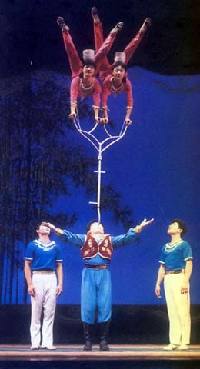
It is an item of feat in acrobatics. The performer balances a cudgel on the head, the forehead or the nose, or holds it in the mouth and put fragile or heavy objects like lamp, vase, desk, bowl or egg, etc on one end of the cudgel to show his/her feat in balancing objects. In some complicated performances, several layers of glasses, lamps or eggs are placed on the cudgel. Some acrobats demonstrate their sleight of hands or play musical instruments while performing the balancing feat.
Circus
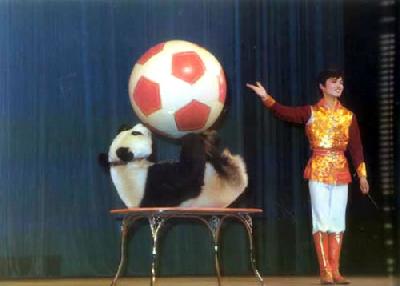
Circus is an ancient feat of acrobatics. In the Tang (618-907) and Song (960-1279) dynasties, circus was very prevalent, and specially referred to taming horses and performance of horsemanship. Today, circus is the collective name of the taming all kinds of animals and acrobatic performances. It usually includes the horsemanship and the performance of various animals that have been trained. Circus generally is held in a square, a specially built circus ground, or a big tent.
Vocal Imitation
Vocal Imitation is one of the fine traditional items in China. Records in ancient classical books can be traced back to as early as 2,300 years ago in the Warring States Period (475-221). Through repeated process by generations of performers, its contents as well as its forms of performance have been greatly enriched. Gastriloquists can imitate the sound of worms, birds, beasts and machines or even the sound made by human activities, such as military drilling, and baby crying. They often accompany their performances with body movements.
Juggling Objects with the Feet
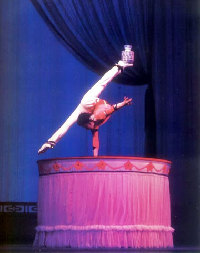
Juggling Objects with the Feet involves objects of varying weight, including heavy objects like wine jar, wood block, ladder, gong and drum, and even quick, and light objects like colored umbrella made of thin silk. The object juggled spins rapidly like flying wheels no matter it is a smooth painted jar made of pottery, or a heavy, square table. In the past, this acrobatics mainly focused on heavy objects, but nowadays it involves both heavy objects and light objects, and performers can shift the object from one foot to the other even it is a colored umbrella or a carpet as thin as a piece of paper.
Jar Tricks
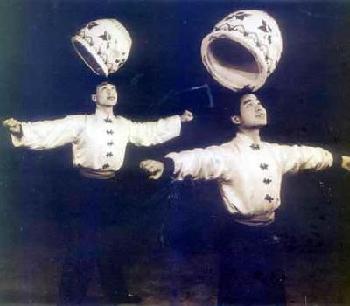
Jar, originally a grain container, is used by the peasants to perform various feats in celebration of a bumper harvest. Later, it was adapted by acrobats and became a very popular number among the broad masses of the people. It demonstrates simplicity and steadiness and possesses a distinctive national flavor.
Tightrope Feats
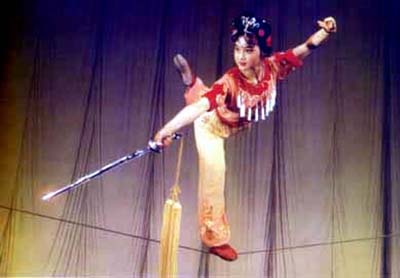
Known as "Rope-Walking" or "Walking on a rope" in ancient China, it is a traditional number recorded with vivid portrayal in the Han Dynasty two thousand years ago. Walking on a wire instead of a rope is a renovation imparting new vigor and skills.
The acrobat uses somersault dexterity that is a basic acrobatic skill to perform such difficult feats as cartwheel, forward and backward somersault, etc. On a trembling wire thus the performance on a tight-wire has been elevated to a new level.
Pole Climbing
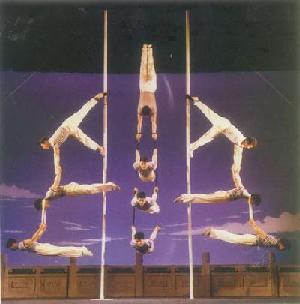
Pole Climbing is one of the main traditional acrobatic numbers in China, vivid description appeared in drawings more than 1,000 years ago. On the basis of Pole Climbing, new acrobatic movements such as jumping from one pole to the other, swift descent and many others are added. It demonstrates resourcefulness, courage and optimism, and brings the art of pole climbing to a new high level.
Plate Spinning
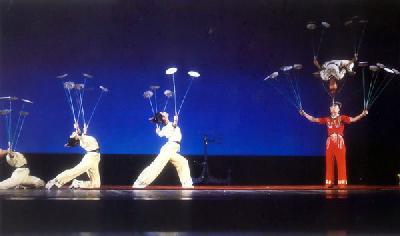
It is also called Juggling Flowery Plates. In the performance, the acrobat holds with both hands two to three thin poles with a plate on the end of each pole, and makes the plates spin rapidly by dint of the brawn. The acrobat is required to perform difficult feats such as flips, carrying swords on the back, holding a flower in the mouth and handstand on a single arm, while ensuring the plates not to fall. Acrobats with high technique can spin about ten plates at the same time.





